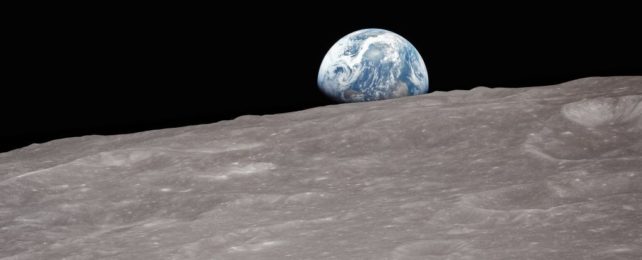Earth and its Moon are unique in the Solar System. Earth is the only planet with just one moon, and that Moon is pretty influential. In fact, without the Moon, life on Earth may not have emerged, some research suggests.
Couple that with a size ratio unlike any other planet-moon system we've seen – the Moon is a little over one-quarter the size of Earth – scientists, naturally, are interested in where the Moon even came from.
Many, like the potato-shaped pair of rocks that orbit Mars, are captured asteroids.
Scientists believe that the origin story of the Moon, however, is one of fire and fury: a vast spray of debris gouged out from a still-warm, barely-formed Earth on a massive collision with a Mars-sized planet named Theia, around 4.5 billion years ago. That debris, the theory goes, coalesced to form our satellite.
Now, we have new evidence of that violent birth.
Isotopes of the noble gasses helium and neon trapped in lunar meteorites recovered from Antarctica match up with those found in the solar wind, without ever having been exposed to it. This, together with a signature argon isotope concentration, suggests that those gasses were inherited from Earth, when the two bodies were one, long ago.
"Finding solar gasses, for the first time, in basaltic materials from the Moon that are unrelated to any exposure on the lunar surface was such an exciting result," said cosmochemist Patrizia Will, formerly of ETH Zurich in Switzerland, now at Washington University in St. Louis.
Directly studying the composition of the Moon is a complicated business. We haven't been there since 1972, and collected samples are scarce.
The Moon, however, does occasionally come to us, in the form of meteorites that are thrown in our direction when something large slams into the surface.
A bunch of these lunar meteorites, or lunaites, have been recovered; there are several hundred that we know of, found all around the world.
The subjects of the study by Will and her colleagues are just six fragments recovered from Antarctica. These fragments are all part of the same original meteoroid, and consist of a very specific kind of rock: unbrecciated – that is, not a 'fruitcake' of multiple rock types, as many meteorites are – basalt from a volcanic plain on the Moon.
This rock formed when magma oozed upward from the interior of the Moon and cooled quickly, covered by more layers of basalt, and thus protected from the ambient environment – including cosmic rays and the solar wind. When the basalt cooled, particles of volcanic glass formed and crystallized, and remained there, under the lunar surface.
There the rock lay, until an impact massive enough to send lunar rocks flying to Earth. Such an impact would have to have been relatively large, gouging deep into the lunar surface to reach rock that had not been exposed for eons.
To find their secrets, the research team studied the lunaites using a noble gas mass spectrometer at the ETH Zurich Noble Gas Laboratory. This instrument is one of the most powerful in the world – and the only one, the researchers said, that is capable of making their detection.
The sub-millimeter glass particles in the basalt, the team found, retained isotopic signatures of helium and neon, like tiny time capsules. And these signatures were the same as the solar wind, but were detected in much higher abundances than expected.
Because the basalt had not been exposed to the solar wind, the gasses had to have come from elsewhere.
The team found the isotope ratios of the neon were very similar to isotope ratios of neon in Earth's mantle plumes, deep upwellings of hot molten that sample reservoirs of material deep inside Earth that are likely undisturbed since the planet formed, 4.5 billion years ago. This similarity suggests that the gasses came from Earth, the researchers concluded.
The discovery may prompt renewed interest in the study of noble gasses in meteorites, and a closer look at what else may be locked up in other lunar rocks, that was previously undetectable but now within reach, such as hydrogen and halogens.
"While such gasses are not necessary for life, it would be interesting to know how some of these noble gasses survived the brutal and violent formation of the Moon," said geochemist Henner Busemann of ETH Zurich.
"Such knowledge might help scientists in geochemistry and geophysics to create new models that show more generally how such most volatile elements can survive planet formation, in our solar system and beyond."
The research has been published in Science Advances.
